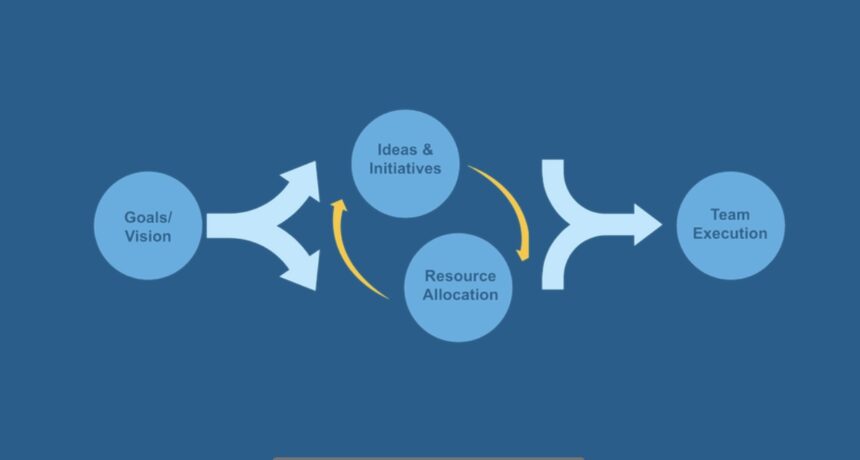In May 2017, I joined a Fintech startup, Feedzai, to build its first product organization and create the product management best practices that connect strategy and execution: customer needs, business goals (OKRs), and long-term product strategies responsively.
Challenges From Rapid Growth
When I joined Feedzai, it was in super growth mode, from ~100 people to 300+ in about a year.
As the customer base expanded, it created a much wider roadmap intake funnel influenced by current customers, prospects, internal teams, and market insights. As a result, the engineering team grew, which formed more scrum teams. Before long, most features started to require multiple scrum teams. Dependencies started to slow everyone down.
Planning and executing on the same 2 week cadence no longer works in growing companies.
– CTO, Feedzai
Teams were busy, while business units didn’t get what they want. There were scrum and sprint metrics but no big picture visibility. No one could answer these 3 basic questions without some effort of digging:
- What features will we launch next month? Why?
- What does it take to add this critical feature in the coming release?
- Which team and skills do we need to hire next? How do we decide?
We also had gaps and misunderstandings between various departments, e.g. Product, Marketing, Sales, and Support as there wasn’t an end-to-end view of bringing the product to the hands of customers.
The Basics
During my first 2 months, I built an end-to-end PDLC process (Product Development Life Cycle) from idea intake and alignment to strategic prioritization, agile development, and go-to-market.
To support these processes, I reconfigured Jira, instituted quarterly and rolling roadmap planning and tracking cadences, and built 4 spreadsheets to manage ideas, product planning, resourcing scenarios, team assignment, and rolling planning (current period execution and next period discovery in parallel).
I made these changes quite quickly, as Feedzai was the 4th growth company I went through this type of transformation with. There were some slight tweaks partnering with product and engineering teams, of course.
The framework, Jira optimization, and a suite of spreadsheets enabled us to plan strategically, flow through to execution, and adjust our plan when new things come to our roadmap. We could now connect strategy and execution but with a lot of effort and meticulous record-keeping and syncing by product managers, engineering managers, and Project managers/ scrum masters. On average, each spent 2 or more days per week on updating spreadsheets, syncing data in different tools, and writing various status updates.
While this sounds challenging, it is not quite unique.
We Needed a Better Tool
A growing company needs to adjust focus frequently – both on the product front as well as the team and resource front. This requires overall visibility, and the ability to re-align initiatives and resources quickly to respond to changes.
However, planning is painful. It takes a lot of time to iterate through various roadmap options within the constraint of resources, timeline, and dependencies (see Build A Better Execution Roadmap). This gets exponentially more complex when the company gets bigger. If a feature requires 2–3 teams or skills, and there are 10+ teams, the permutation combination can get out of control very quickly. At most, we do 2–3 iterations of roadmap options and quit then. We simply run out of energy and time to find the best combination. And even if we’ve “locked down” the upcoming roadmap (next month or quarter), things change… and the pain will start all over again.
While many companies practice big picture planning (connect strategy and execution) to complement agile execution, the way we manage this process has not changed for 20 years.
Spreadsheet + meetings + presentation is still how most teams connect the dots between strategy and execution.
The Lightbulb Moment
In the preceding 3 years, I’ve been on several tool hunts, tried and used dozens of roadmap and project portfolio tools, including Aha!, Portfolio for Jira, Roadmunk, Product Plan, Airtable, Trello (on steroids), Smartsheet, Asana, Monday (back then it was called Dapulse) and even “old school” tools like Planview and Clarity (CA PPM). I also did many interviews with many Product, PMO, and engineering leaders. There was no modern tool to connect strategy and execution and enable cross-functional collaboration.
When 2 engineering leaders from 2 different companies reached out for suggestions on a “better spreadsheet” to manage their roadmaps and resources… I realized they didn’t need a better spreadsheet, they needed an intelligent system to connect strategy and execution and support iterative planning to respond to changes quickly.
I decided to build one – This is the start of Dragonboat – the smart, complete, and Responsive Product Portfolio platform to help companies build better products and teams.



